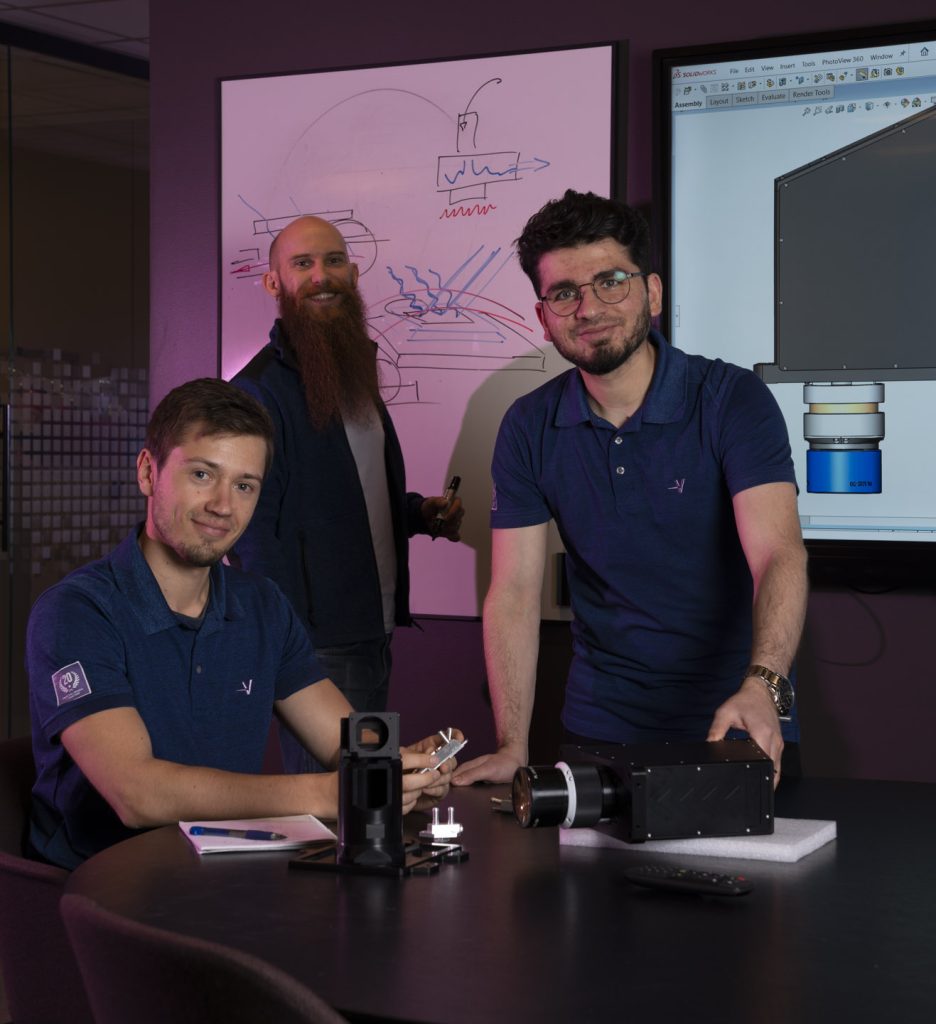Speed, resolution, and build area for powder bed fusion
The LUXBEAM® Rapid System LRS-MCx NIR removes the traditional limitations of polymer-based powder bed fusion (PBF). The subsystem opens new doors for high-throughput, high-resolution additive manufacturing using PBF with unprecedented near-infrared power and flexible static or scrolling arrangement options.
Recommended use

Maximum throughput
in powder bed fusion
Visitech introduces the LRS-MCx NIR light engine, providing unprecedented near-infrared power of more than 100 W in the projected 2D image. The subsystem offers a path toward high-productivity systems for polymer-based powder bed fusion (PBF).
An alternative to classical selective laser sintering (SLS) technologies – where the polymer material is heated up sequentially, point-by-point, and layer-by-layer, the LUXBEAM® Rapid System LRS-MCx NIR rationalizes toward a pure layer-by-layer approach, with instant 2D imaging.

Direct Image Sintering (DIS): The new PBF method
Visitech’s new DIS concept uses DLP and powerful IR laser diode arrays to substantially increase print speed, resolution, and build area over traditional polymer PBF methods. Exposing the entire print layer in one shot is the critical driver of build speed.
Applying Visitech’s scrolling subsystem, stacking multiple, powerful IR light engines in a motion stage that scrolls them over a vast build area effectively removes established polymer-based PBF limitations.
With the DIS concept’s ability to maintain high resolution across the build area, a world of opportunities opens for innovative system builders seeking actual mass production capabilities for their polymer powder bed fusion systems.
Accelerating powder bed fusion
The liquid-cooled LRS-MCx NIR modules offer stackability for stitched images in static, step-and-flash, or scrolling configurations. This enables the highest manufacturing throughput for single-pass linear motion systems.
In addition, alignment features grant pixel-precise alignment of the modules. Featuring the highly robust and reliable high-resolution DLP650LNIR WXGA chipset, the system operates with an external, fiber-coupled NIR laser in the 800-1200 nm range.
Unique light source
The LRS-MCx NIR light engine comprises a proprietary integrated laser diode module for maximum throughput control, safeguarding system components such as the DMD at their best—for static or dynamic implementations.
Advanced controller
The LAMA software package and API enable you to select any motion controller in its basic configuration for the LRS-MCx NIR. 10G bandwidth even allows streaming. However, achieving maximum performance and complete functionality requires a dedicated motion controller configuration.
LUXBEAM® LRS-MCx MOTION STAGE:
Plug-and-play solution for multihead scrolling

Enlarging the build area
While introducing multihead scrolling as the most advanced solution for scaling up 3D print stereolithography system productivity, Visitech adds a plug-and-play reference stage to its portfolio. Implementing scalable motion systems allows for enlarged build areas. It is designed for expert static 3D print machine developers and manufacturers, who will find that the improved productivity of the LRS-MCx motion stage opens up new business opportunities for exploration.
Flexible motion stage platform
Designed for installation in bottom-up and top-down configurations, the motion stage can accommodate up to four LRS-MCx photo heads. A wide selection of projection lenses enables various configuration options, allowing for seamless stitching of native images with pixel pitches as small as 50 microns. The motion stage’s flexible platform is suitable for UV stereolithography and works equally well in polymer-based powder bed fusion installations.
| Properties | ||||
|---|---|---|---|---|
| DMD Type | DLP650LNIR 0,65” WXGA (NIR) | |||
| Resolution | 1280 x 800 px | |||
| Operation Mode | Native pixel mode, scrolling / Subpixelation SPX mode (requires LAMA Pro) | |||
| Projector Output Power | Up to 100 Watts | |||
| LED Options | 1064nm (LASER) | |||
| LED Driver | IgnitIR | |||
| Power Uniformity | > 99% after Software Correction | |||
| Dimensions w/o lens | 305 mm (H) x 92 mm (W) x 240 mm (L) | |||
| Total weight w/o PSU | 5 kg (w/o lens) | |||
| Power consumption | Max 1000 Watts | |||
| Cooling system | Liquid cooling | |||
| Software | Complete API (Windows, Linux), platform-independent web interface Advanced Control SW package (optional) | |||
| Features | NEOS, PPC (LAMA STD), SSw | |||
| Electrical connections | Signal | |||
|---|---|---|---|---|
| Power supply | 12 V DC | |||
| Image Data | Pattern Streaming with LAMA | |||
| Communication | Ethernet | |||
| UV / IR Safety | LED Safety Switch (enable/disable) | |||
| Frame Sync | External Frame Synchronization | |||
| Lens Options | Pixel Pitch in image [μm] | Native Image Size W x H [mm2] | Working Distance [mm] | Mounting Distance [mm] | ||
|---|---|---|---|---|---|---|
| MCx 1.85x NIR | 20.0 | 25.6 x 16.0 | 71.0 | 186 | ||
| MCx 3.7x NIR | 40.0 | 51.2 x 32.0 | 150.0 | 299 | ||
| MCx 7.0x NIR | 75.0 | 96.0 x 60.0 | 220.0 | 351 | ||
| MCx 16.0x NIR | 175.0 | 224.0 x 140.0 | 210.0 | 348 | ||
| Other lens options are available upon request. All specifications and features are subject to change. | ||||||
Need more details?
We have more information for you! Please get in touch.
